Related Research Articles

The Holy Roman Empire, also known as the Holy Roman Empire of the German Nation after 1512, was a polity in Central and Western Europe, usually headed by the Holy Roman emperor. It developed in the Early Middle Ages and lasted for almost one thousand years until its dissolution in 1806 during the Napoleonic Wars.
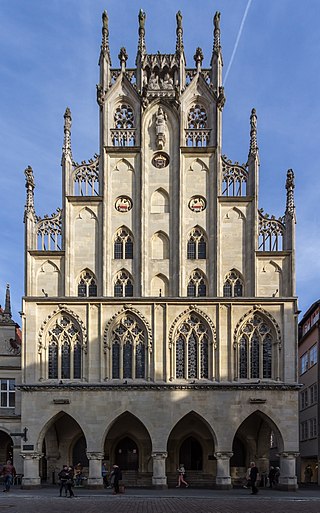
The Peace of Westphalia is the collective name for two peace treaties signed in October 1648 in the Westphalian cities of Osnabrück and Münster. They ended the Thirty Years' War (1618–1648) and brought peace to the Holy Roman Empire, closing a calamitous period of European history that killed approximately eight million people. Holy Roman Emperor Ferdinand III, the kingdoms of France and Sweden, and their respective allies among the princes of the Holy Roman Empire, participated in the treaties.

Imperial Reform is the name given to repeated attempts in the 15th and 16th centuries to adapt the structure and the constitutional order of the Holy Roman Empire to the requirements of the early modern state and to give it a unified government under either the Imperial Estates or the emperor's supremacy.

Count Wilhelm Kinsky von Wchinitz was a Czech landowner and a statesman. By birth, he was member of the House of Kinsky, which belonged to the highest circle of Bohemian aristocracy.
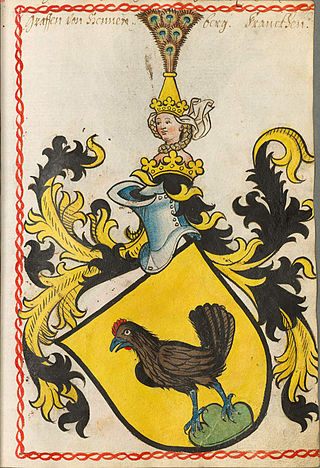
Bertold von Henneberg-Römhild (1442–1504) was Archbishop of Mainz and Prince-elector of the Holy Roman Empire from 1484, imperial chancellor from 1486, and leader of the reform faction within the Empire.

The word Kleinstaaterei is a pejorative term coined in the early nineteenth century to denote the territorial fragmentation of Germany. While the term referred primarily to the territorial fragmentation of the German Confederation, it is also applied by extension to the even more extreme territorial fragmentation of the Holy Roman Empire. In this period, Germany was split into a great number of nearly sovereign small and medium-sized secular and ecclesiastical principalities and free imperial cities, some of which were little larger than a single town or the surrounding grounds of the monastery of an Imperial abbey. Estimates of the total number of German states at any time during the 18th century vary, ranging from 294 to 348 or more; however, the number of states rapidly decreased with the onset of German mediatisation in the early 19th century.

The Peace of Leoben was a general armistice and preliminary peace agreement between the Holy Roman Empire and the First French Republic that ended the War of the First Coalition. It was signed at Eggenwaldsches Gartenhaus, near Leoben, on 18 April 1797 by General Maximilian von Merveldt and the Marquis of Gallo on behalf of the Emperor Francis II and by General Napoléon Bonaparte on behalf of the French Directory. Ratifications were exchanged in Montebello on 24 May, and the treaty came into effect immediately.
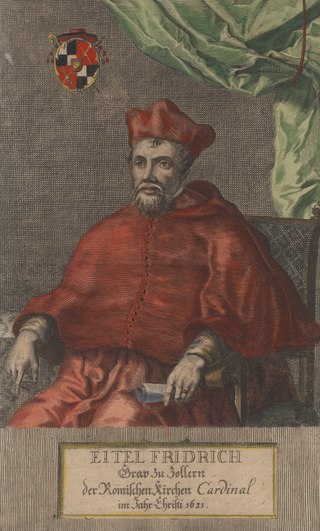
Eitel Friedrich von Hohenzollern-Sigmaringen was a Roman Catholic Cardinal-Priest and Prince-Bishop of Osnabrück. He was a son of Charles II, Count of Hohenzollern-Sigmaringen and thus a member of the noble and ancient Hohenzollern-Sigmaringen family.

The German-speaking states of the early modern period were divided politically and religiously. Religious tensions between the states comprising the Holy Roman Empire had existed during the preceding period of the Late Middle Ages, notably erupting in Bohemia with the Hussite Wars (1419–1434). The defining religious movement of this period, the Reformation, led to unprecedented levels of violence and political upheaval for the region.
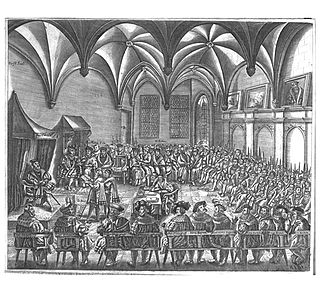
The reservatum ecclesiasticum was a provision of the Peace of Augsburg of 1555. It exempted ecclesiastical lands from the principle of cuius regio, eius religio, which the Peace established for all hereditary dynastic lands, such as those ruled by princes or dukes. Under this principle, the religion of the ruler would be the religion of the country and of its people, those being his possession by inheritance.
The Princes' Concordat was an agreement concluded in January 1447 between Pope Eugenius IV and the prince-electors of the Holy Roman Empire. It outlined generous concessions on the part of the Pope, particularly covering the appointment of Church positions, in exchange for the support of the German princes.
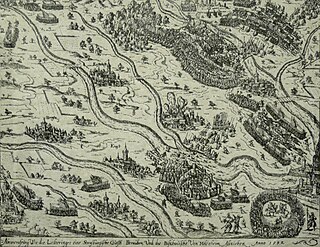
The Strasbourg Bishops' War (1592–1604) was a conflict between Catholics and Protestants for control of the Bishopric of Strasbourg. It was one of only two sectarian or confessional conflicts, both highly localised, that occurred within the Holy Roman Empire between the Peace of Augsburg (1555) and the outbreak of the Thirty Years' War (1618). It was less bloody than the Cologne War (1583–88). It coincided with the Counter-Reformation and the Spanish Winter (1598–99), and the Catholic victory caused Protestants in Germany great worry that the tide had turned decidedly against them.
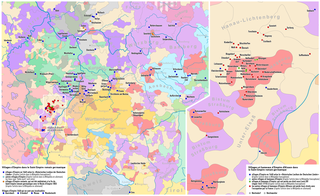
The imperial villages were the smallest component entities of the Holy Roman Empire. They possessed imperial immediacy, having no lord but the Emperor, but were not estates. They were unencircled and did not have representation in the Imperial Diet. In all these respects they were similar to the Imperial Knights. The inhabitants of imperial villages were free men.
Johann von Leuchselring was Chancellor for the Free Imperial City of Augsburg from 1636 through 1645 and a leading Catholic negotiator in the Peace of Westphalia.
The itio in partes was a procedure of the Imperial Diet of the Holy Roman Empire between 1648 and 1806. In this procedure, the members of the diet divided into two bodies (corpora), the Corpus Evangelicorum and the Corpus Catholicorum, irrespective of the colleges to which they otherwise belonged. That is, the Protestant (Evangelical) members of the College of Electors, the College of Princes and the College of Cities gathered together separately from the Catholic members of the same. The two bodies then negotiated with each other, but debated and voted among themselves. A decision was reached only when both bodies agreed. The itio in partes could be invoked whenever there was a unanimous vote of one body. At first, it could only be invoked in matters affecting religion, but gradually this requirement was dropped.
A Reichskrieg was a war fought by the Holy Roman Empire as a whole against a common enemy. After the Peace of Westphalia in 1648, a Reichskrieg was a formal state of war that could only be declared by the Imperial Diet.

The Treaty of Schönbrunn was a treaty of friendship signed between France and Prussia at Schönbrunn Palace in Vienna on 15 December 1805, during the Napoleonic Wars. The terms were negotiated by Géraud Duroc, who signed for France, and Christian Graf von Haugwitz, who signed for Prussia. The convention was superseded by the Treaty of Paris of 15 February 1806, which incorporated its main terms.

The Principality of Heitersheim was an imperial estate of the Holy Roman Empire from 1548 until 1806. It was a territory of the Knights Hospitaller consisting of several noncontiguous enclaves in the Breisgau. It was a member of the Upper Rhenish Circle. Before its expansion in 1803, it had an area of about 4 square Reichsmeilen and a population of about 5 000.
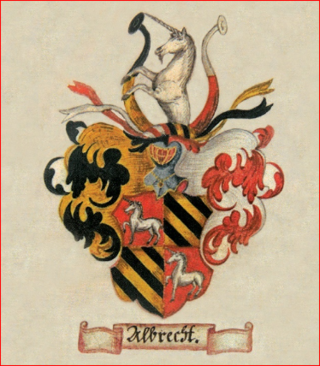
The Albrecht of Rothenburg ob der Tauber was a patrician family, many of whose members occupied administrative offices in both the Interior and Exterior Councils that governed the Imperial Free City of Rothenburg ob der Tauber during the second half of the Holy Roman Empire. In addition to performing various judicial, religious and administrative roles in their home city, several Albrechts also wrote University theses that contributed, in the wider context of defining German national identity, to Law and Legal Theory during the years that spanned the Protestant Reformation, the Thirty Years War, the war's aftermath, and the German Enlightenment.
The guarantors of the imperial constitution or guarantor powers were those states that were, by treaty, obligated to defend the constitution of the Holy Roman Empire. Starting in 1648 the guarantor powers were Sweden and France, joined by Russia in 1779.
References
- ↑ Sanders, Glenn E. (Winter 1998). "Reviewed Work: The Dutch Republic: Its Rise, Greatness, and Fall, 1477–1806. Volume I, The Oxford History of Early Modern Europe by Jonathan Israel". The Historian. 60 (2): 433–434. JSTOR 24451791.
- ↑ Tracy, James D. (Spring 1997). "Reviewed Work: The Dutch Republic: Its Rise, Greatness, and Fall, 1477-1806. by Jonathan Israel". The Sixteenth Century Journal. 28 (1): 382–384. doi:10.2307/2543349. JSTOR 2543349.
- ↑ Mörke, Olaf (1996). "Reviewed Work: The Dutch Republic. Its Rise, Greatness, and Fall (1477-1806) by Jonathan Israel". Zeitschrift für Historische Forschung (in German). Duncker & Humblot GmbH. 23 (3): 388–390. JSTOR 43572412.
- ↑ Dunthorne, Hugh (September 1996). "Reviewed Work: The Dutch Republic. Its Rise, Greatness, and Fall, 1477-1806 by Jonathan Israel". The English Historical Review. Oxford University Press. 111 (443): 943–945. doi:10.1093/ehr/CXI.443.943. JSTOR 577570.
- ↑ Pelus-Kaplan, Marie-Louise (July–August 2000). "Reviewed Works: The Dutch Republic. Its Rise, Greatness, and Fall 1477-1806 by Jonathan I. Israel; A Miracle Mirrored. The Dutch Republic in European Perspective by Karel Davids, Jan Llucassen". Annales. Histoire, Sciences Sociales (in French). Cambridge University Press. 55e Année (4): 899–901. doi:10.1017/S0395264900042013. JSTOR 27586374.
- ↑ TeBrake, William H. (December 1996). "Reviewed Work: The Dutch Republic: Its Rise, Greatness, and Fall, 1477-1806 by Jonathan Israel". The American Historical Review. Oxford University Press on behalf of the American Historical Association. 101 (5): 1562–1563. doi:10.2307/2170245. JSTOR 2170245.
- 1 2 Higgins, Padhraig (January 2010). "Reviewed Works: Contested Island: Ireland 1460–1630 by S. J. Connolly; Divided Kingdom: Ireland 1630–1800 by S. J. Connolly". History. 95 (1 (317)): 118–120. doi:10.1111/j.1468-229X.2009.00476_27.x. JSTOR 24429174.
- 1 2 Chambers, Liam (2009). "Review: Adapting Early Modern Ireland. Reviewed Works: Contested Island: Ireland, 1460-1630 by S.J. Connolly; Divided Kingdom: Ireland 1630-1800 by S.J. Connolly". Eighteenth-Century Ireland / Iris an Dá Chultúr. Eighteenth-Century Ireland Society. 24: 164–175. doi:10.3828/eci.2009.12. JSTOR 27806961.
- ↑ McCormack, Anthony M. (2008–2009). "Reviewed Work: Contested island: Ireland 1460-1630 by S.J. Connolly". Studia Hibernica. Liverpool University Press (35): 241–243. JSTOR 40732191.
- ↑ Bartlett, Thomas (November 2009). "Reviewed Work: Divided kingdom: Ireland, 1630-1800 by S. J. Connolly". Irish Historical Studies. Cambridge University Press. 36 (144): 630–631. doi:10.1017/S0021121400006039. JSTOR 20750006. S2CID 163808699.
- ↑ Fleming, David (Winter 2009). "Review: Dominating Politics. Reviewed Work: Divided Kingdom: Ireland, 1630-1800 by S.J. Connolly". The Irish Review. Cork University Press (40/41): 192–193. JSTOR 20750115.
- 1 2 Wilson, Peter H. (June 2013). "Reviewed Work: Germany and the Holy Roman Empire 1493-1806. Vol. I: Maximilian I to the Peace of Westphalia 1493-1648.Vol. II: The Peace of Westphalia to the Dissolution of the Reich 1648-1806 by Joachim Whaley". Central European History. Cambridge University Press on behalf of Central European History Society. 46 (2): 407–413. doi:10.1017/S0008938913000678. JSTOR 43280589. S2CID 231895642.
- 1 2 Valente, Michaela (January–March 2013). "Reviewed Work: Germany and the Holy Roman Empire. 2 voll. Volume I: Maximilian I to the Peace of Westphalia, 1493-1648.Volume II: The Peace of Westphalia to the Dissolution of the Reich, 1648-1806 by WhaleyJoachim". Archivio Storico Italiano (in Italian). Casa Editrice Leo S. Olschki s.r.l. 171 (1 (635)): 191–192. JSTOR 26226186.
- 1 2 Midelfort, H. C. Erik (Winter 2012). "Reviewed Works: Germany and the Holy Roman Empire, vol. 1, Maximilian I to the Peace of Westphalia, 1493–1648 by Joachim Whaley; Germany and the Holy Roman Empire, vol. 2, The Peace of Westphalia to the Dissolution of the Reich, 1648–1806 by Joachim Whaley". The Sixteenth Century Journal. 43 (4): 1225–1227. JSTOR 24245045.
- 1 2 Scott, Tom (August 2012). "Reviewed Work: Germany and the Holy Roman Empire, Volume I: Maximilian I to the Peace of Westphalia, 1493—1648; Volume II: The Peace of Westphalia to the Dissolution of the Reich, 1648—1806 by Joachim Whaley". The English Historical Review. Oxford University Press. 127 (527): 984–987. doi:10.1093/ehr/ces175. JSTOR 23272711.
- 1 2 Haug-Moritz, Gabriele (2014). "Reviewed Works: Germany and the Holy Roman Empire, 2 Bde., Bd. 1: Maximilian I. to the Peace of Westphalia 1493-1648, Bd. 2: The Peace of Westphalia to the Dissolution of the Reich 1648-1806 by Joachim Whaley; The Holy Roman Empire 1495-1806 by Peter H. Wilson". Zeitschrift für Historische Forschung. Duncker & Humblot GmbH. 41 (2): 281–284. JSTOR 43612494.
- ↑ Warren, Jared (2017–2018). "Reviewed Work: THE OXFORD HISTORY OF POLAND-LITHUANIA. Vol. 1, THE MAKING OF THE POLISH-LITHUANIAN UNION, 1385-1569 by Robert Frost". Harvard Ukrainian Studies. Ukrainian Research Institute. 35 (1/4, THE BATTLE FOR UKRAINIAN: A COMPARATIVE PERSPECTIVE): 531–532. JSTOR 44983557.
- ↑ Martin, Alexander M. (March 2019). "Book Reviews. The Russian Empire, 1450–1801. By Nancy Shields Kollmann". The Journal of Modern History. 91 (1): 233–235. doi:10.1086/701573. S2CID 150656167.